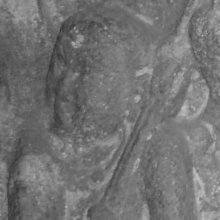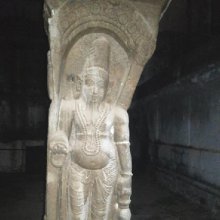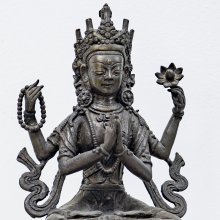Akshamala, Akṣamālā, Aksha-mala: 20 definitions
Introduction:
Akshamala means something in Hinduism, Sanskrit, Marathi. If you want to know the exact meaning, history, etymology or English translation of this term then check out the descriptions on this page. Add your comment or reference to a book if you want to contribute to this summary article.
The Sanskrit term Akṣamālā can be transliterated into English as Aksamala or Akshamala, using the IAST transliteration scheme (?).
Images (photo gallery)
In Hinduism
Purana and Itihasa (epic history)
Source: Google Books: Cultural History from the Vāyu PurānaAkṣamālā (अक्षमाला)—One of the Heavenly ornaments according to the Vāyu Purāṇa. In the seventh Rasātala (i.e., Pātāla) rules king Bali adorned with an akṣamālā.
Source: archive.org: Puranic EncyclopediaAkṣamālā (अक्षमाला).—(ARUNDHATĪ). See under Arundhatī.
Source: archive.org: Shiva Purana - English TranslationAkṣamāla (अक्षमाल) refers to a “Rudrākṣa garland”, according to the Śivapurāṇa 2.2.40.—Accordingly, as Brahmā narrated to Nārada:—“[...] after going beyond Alakā, the capital of the king of Yakṣas and the Saugandhika park, they saw the fig-tree of Śiva. [...] Beneath that vaṭa of yogic potentialities, Viṣṇu and other Devas saw Śiva seated. [...] He had put his left leg over his right thigh and knee. The Rudrākṣa garland (i.e., akṣamāla) was suspended from his wrist. He was showing the Tarkamudrā (with his hand)”.
Source: Cologne Digital Sanskrit Dictionaries: The Purana IndexAkṣamālā (अक्षमाला).—Of Śeṣa; see akṣasūtra.*
- * Vāyu-purāṇa 50. 50.

The Purana (पुराण, purāṇas) refers to Sanskrit literature preserving ancient India’s vast cultural history, including historical legends, religious ceremonies, various arts and sciences. The eighteen mahapuranas total over 400,000 shlokas (metrical couplets) and date to at least several centuries BCE.
Shilpashastra (iconography)
Source: Google Books: Elements of Hindu iconographyAkṣamālā (अक्षमाला) is the rosary of beads. The beads are either rudrākṣa or kamalākṣa in variety, and the rosary is found in the hands of Brahmā, Sarasvatī and Śiva, though rarely in association with other deities.
Source: Google Books: Sarasvatī: Riverine Goddess of Knowledge (iconography)Akṣamālā (अक्षमाला, “rosary”).—An object being held by the four-armed Sarasvatī;—According to the Viṣṇudharmottara-purāṇa 3.64.4, the rosary in Sarasvatī’s hand represents time. The rosary is most commonly called akṣamālā, where akṣa is the seed or the fruit of the Terminalia bellerica tree (vibhīdaka/vibhītaka). The rosary is made from the seeds of this tree, strung up into a garland (mālā). Whereas in the Viṣṇudharmottara-purāṇa 3.64.2 Sarasvatī’s rosary is referred to as akṣamālā, in the Matsya-purāṇa 66.10, it is called akṣamaṇi, a necklace of akṣa. Sūtra, ‘thread, string’, is also sometimes used instead of mālā, as in the Matsya-purāṇa 261.25, where Brahmāṇī carries an akṣasūtra.
Source: Shodhganga: The significance of the mūla-beras (śilpa)Akṣamālā (अक्षमाला, “prayer beads”) refers to one of the several “attributes” (āyudha) or “accessories” of a detiy commonly seen depicted in Hindu iconography, defined according to texts dealing with śilpa (arts and crafs), known as śilpaśāstras.—The śilpa texts have classified the various accessories under the broad heading of āyudha or karuvi (implement), including even flowers, animals, and musical instruments. The other miscellaneous articles found as attributes in the hands of the deities are, for example, Akṣamālā.
Akṣamālā is the “rosary of beads”. The beads are either rudrākṣa or kamalākṣa in variety, and the rosary is found on the hands of Brahmā, Sarasvatī and Śiva, though rarely in association with other deities.

Shilpashastra (शिल्पशास्त्र, śilpaśāstra) represents the ancient Indian science (shastra) of creative arts (shilpa) such as sculpture, iconography and painting. Closely related to Vastushastra (architecture), they often share the same literature.
Shaktism (Shakta philosophy)
Source: Google Books: ManthanabhairavatantramAkṣamālā (अक्षमाला) refers to a “rosary” and is used to visualize Bhairava, according to the Manthānabhairavatantra, a vast sprawling work that belongs to a corpus of Tantric texts concerned with the worship of the goddess Kubjikā.—Accordingly, “He has eight faces and, very powerful, shines like a white lotus. He is mightily proud and has sharp teeth and great body. He is terrible and fierce and his face is deformed. O Śambhu, he has twenty arms and the goddess sits on his lap. He holds a sword, mallet and noose, a double-headed drum, a dagger, the Kaustubha jewel, a rosary [i.e., akṣamālā], a skull bowl full of fruit and the like and a piece of human flesh. [...]”.

Shakta (शाक्त, śākta) or Shaktism (śāktism) represents a tradition of Hinduism where the Goddess (Devi) is revered and worshipped. Shakta literature includes a range of scriptures, including various Agamas and Tantras, although its roots may be traced back to the Vedas.
General definition (in Hinduism)
Source: Google Books: Ritual and Speculation in Early TantrismAkṣamālā (अक्षमाला):—The rosary (akṣamālā) is said to be of tow kinds: created and uncreated. The created one is made of beads; the uncreated one [consists of] the syllables of the alphabet. It is called a-kṣa-mālā because it consists of the bead-like syllables from a to kṣa. The excellent knower of mantras should count these in regular and reversed order. A single result is produced by counting the number of repetitions with the fingers; the result is tenfold when counting by drawing lines on the ground, wall, etc.; it is 100,000-fold when counting with precious stones; it is said to be infinite when count with rubies.
Languages of India and abroad
Marathi-English dictionary
Source: DDSA: The Molesworth Marathi and English Dictionaryakṣamālā (अक्षमाला).—f (S) A string of beads, a rosary.
Source: DDSA: The Aryabhusan school dictionary, Marathi-Englishakṣamālā (अक्षमाला).—f A string of beads, a rosary.
Marathi is an Indo-European language having over 70 million native speakers people in (predominantly) Maharashtra India. Marathi, like many other Indo-Aryan languages, evolved from early forms of Prakrit, which itself is a subset of Sanskrit, one of the most ancient languages of the world.
Sanskrit dictionary
Source: DDSA: The practical Sanskrit-English dictionaryAkṣamālā (अक्षमाला).—[akṣāṇāṃ mālā -sūtram]
1) a rosary, string of beads (akārādikṣakārāntaḥ akṣaḥ tatkṛtā tatpratinidhibhūtā vā mālā); कृतो- ऽक्षसूत्रप्रणयी तया करः (kṛto- 'kṣasūtrapraṇayī tayā karaḥ) Kumārasambhava 5.11,66; °मालामुपयाचितुमागतोऽस्मि (mālāmupayācitumāgato'smi) K.151. (It is made of rudrākṣa seeds, corals, crystals, rubies, gems &c.)
2) Name of अरुन्धती (arundhatī) (akṣamālā tvarundhatī Hm.); अक्ष- माला वसिष्ठेन संयुक्ताधमयोनिजा (akṣa- mālā vasiṣṭhena saṃyuktādhamayonijā)...जगामाभ्यर्हणीयताम् (jagāmābhyarhaṇīyatām) Manusmṛti 9.23. मातङ्गयामक्षमालायां गर्हितायां रिरंसया (mātaṅgayāmakṣamālāyāṃ garhitāyāṃ riraṃsayā) | Bu. ch.4.77. (akṣasya nakṣatracakrasya māleva bhūṣaṇatvāt; sā hyuttarasyāṃ diśi gagane saptarṣimaṇḍale mālārūpeṇa vasiṣṭhasamīpe vartate sarvebhyaścojjvalatvāttasyā mālārūpeṇa sthitatvācca nakṣatracakrabhūṣaṇatvam Tv).
Akṣamālā is a Sanskrit compound consisting of the terms akṣa and mālā (माला). See also (synonyms): akṣasūtra.
Source: Cologne Digital Sanskrit Dictionaries: Shabda-Sagara Sanskrit-English DictionaryAkṣamālā (अक्षमाला).—f.
(-lā) 1. A rosary, a string of beads, especially of the seeds of the Eleocarpus. 2. The name of Arundhati, wife of Vasisht'- Ha, (from her wearing a rosary.) E. akṣa a kind of seed or bead, and mālā a necklace.
Source: Cologne Digital Sanskrit Dictionaries: Benfey Sanskrit-English DictionaryAkṣamāla (अक्षमाल).—f. lā, 1. a rosary, [Devīmāhātmya, (ed. Poley.)] 2, 23. 2. a name of Arundhatī, the wife of Vaśiṣṭha, [Mānavadharmaśāstra] 9, 23.
Akṣamāla is a Sanskrit compound consisting of the terms akṣa and māla (माल).
Source: Cologne Digital Sanskrit Dictionaries: Cappeller Sanskrit-English DictionaryAkṣamālā (अक्षमाला).—[feminine] rosary, string of beads (also likā [feminine]); [Epithet] of Arundhatī.)
Source: Cologne Digital Sanskrit Dictionaries: Monier-Williams Sanskrit-English Dictionary1) Akṣamālā (अक्षमाला):—[=akṣa-mālā] [from akṣa > akṣ] f. a string or rosary of beads, especially of Eleocarpus seeds
2) [v.s. ...] Name of Arundhatī, wife of Vasiṣṭha (from her wearing a rosary), [Manu-smṛti ix, 23]
3) [v.s. ...] Name of the mother of Vatsa.
Source: Cologne Digital Sanskrit Dictionaries: Goldstücker Sanskrit-English DictionaryAkṣamālā (अक्षमाला):—f.
(-lā) I. [tatpurusha compound] A rosary, a string of beads, especially of the seeds of the Eleocarpus. Ii. [bahuvrihi compound] The name of Arundhati, wife of Vasiṣṭha, (from her wearing a rosary.) E. akṣa (a kind of seed or bead) and mālā.
Source: Cologne Digital Sanskrit Dictionaries: Yates Sanskrit-English DictionaryAkṣamālā (अक्षमाला):—[akṣa-mālā] (lā) 1. f. A rosary.
[Sanskrit to German]
Sanskrit, also spelled संस्कृतम् (saṃskṛtam), is an ancient language of India commonly seen as the grandmother of the Indo-European language family (even English!). Closely allied with Prakrit and Pali, Sanskrit is more exhaustive in both grammar and terms and has the most extensive collection of literature in the world, greatly surpassing its sister-languages Greek and Latin.
See also (Relevant definitions)
Partial matches: Aksha, Maala, Mala.
Starts with: Akshamaladhara, Akshamalapratishtha.
Ends with: Drakshamala, Kakshamala, Rakshamala, Rudrakshamala, Tarunikatakshamala.
Full-text (+33): Akshasutra, Akshamalin, Virupaksha, Nalinatcamalai, Kuja, Akkamalai, Sarasvati, Kiranaksha, Aparajita, Jayanta, Prajapati, Hara, Gajasura, Tryambaka, Revata, Ekapada, Aja, Bahurupa, Samyukta, Brahma.
Relevant text
Search found 24 books and stories containing Akshamala, Akṣa-mālā, Aksa-mala, Akṣa-māla, Akṣamālā, Aksamala, Akṣamāla, Aksha-mala; (plurals include: Akshamalas, mālās, malas, mālas, Akṣamālās, Aksamalas, Akṣamālas). You can also click to the full overview containing English textual excerpts. Below are direct links for the most relevant articles:
Shaiva Upanishads (A Critical Study) (by Arpita Chakraborty)
13-14. Description of Akṣa-beads in the Akṣamālikā Upaniṣad < [Chapter 4 - A Critical approach to Rudrākṣa based on Śaiva Upaniṣads]
The Devi Bhagavata Purana (by Swami Vijñanananda)
Chapter 2 - On the description of the Śaktis, etc., of the syllables of Gāyatrī < [Book 12]
Chapter 17 - On the description of Sandhyā and other daily practices < [Book 11]
Manusmriti with the Commentary of Medhatithi (by Ganganatha Jha)
Verse 9.23 < [Section I - Husband and Wife]
Cosmetics, Costumes and Ornaments in Ancient India (by Remadevi. O.)
2.5. Various other Hand Ornaments < [Chapter 3 - Ornaments]
Lakulisha-Pashupata (Philosophy and Practice) (by Geetika Kaw Kher)
Vyakhyana Daksinamurti < [Chapter 3 - The Ritualistic Context]
Vietnamese Buddhist Art (by Nguyen Ngoc Vinh)
4. Avalokitesvara images in Cambodia < [Chapter 3 - Unifying factors of the Avalokitesvara Images in South Vietnam and South East Asia]
3. Avalokitesvara images in Funan < [Chapter 3 - Unifying factors of the Avalokitesvara Images in South Vietnam and South East Asia]
Related products






